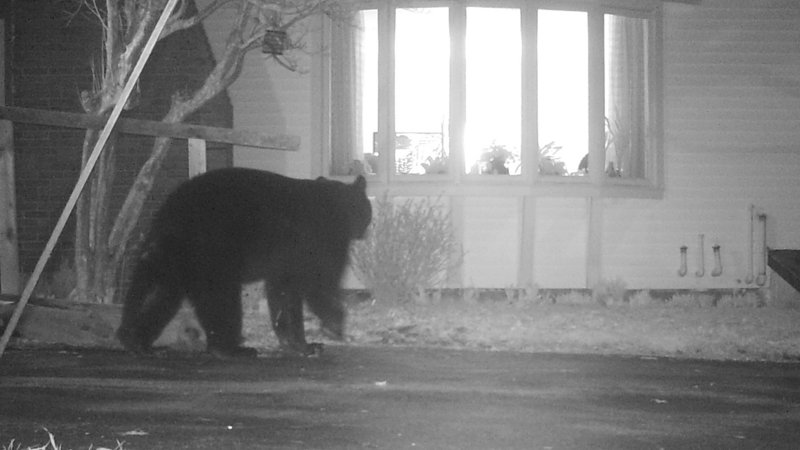After more than 40 years as a guide in northern Maine, Wayne Bosowicz, a self-taught wildlife expert, knows it can be hard to keep bears and people apart, especially when food and foolishness collide.
He recalls seeing a man who spotted a black bear at a town landfill get out of his car with a bag of M&Ms in his hands. From a distance, the man tossed a few candies to the bear, drawing it closer and closer, until the beast padded up and clawed the bag of candy out of his hands.
“People sometimes are the biggest problem,” said Bosowicz, owner of Foggy Mountain Guide Service in Sebec. “Someone gets raked, and then they want all the bears shot. You almost want to shoot the people.”
Officials from the state Department of Inland Fisheries and Wildlife report that seeing black bears up close is becoming more common, as bears’ habitat in northern Maine shrinks and the human population in the southern half of the state grows.
Prompted by an unusually high number of bear-human interactions last year, they are warning people to be careful about encounters with the animals, which can weigh 300 to 600 pounds.
People are being advised to stay alert — especially from dusk into the dead of night — and to eliminate conditions that attract bears — namely bird seed, garbage and deliberate feeding, said Doug Rafferty, director of public information and education with the department.
In 2012, the Maine Warden Service received 870 bear-related complaints, compared with 395 in 2010 and 436 in 2011. Last year’s increase is explained in part by a relatively warm winter and an early spring that brought hungry bears into contact with curious and unwitting humans.
“There are probably more bear in the state than ever in the history of the state,” said Bosowicz.
Right now, as mud season wears on, bears are ravenous. Initially, they’ll take whatever they can get — soft vegetation to start. But soon they’ll be longing for something more tasty, like bird seed or soggy food waste.
A bear’s stomach shrinks during denning to the size of a clenched fist, said Bosowicz, who has studied bears for nearly 40 years.
“The first thing they eat is grass … along streams and brooks, and buds,” he said. Each week, they extend their territory to find more to eat until mid-June, when they reach their normal shape, stature and appetite. Then, they tend to drift farther back into the forests, away from people.
For now, if you see a bear, steer clear.
“A safe distance would be inside the house,” said Rafferty. “That would work for anybody, I think.”
And as the weather warms and camping begins, apply those precautions at day’s end to outdoor recreation.
“Get everything in,” said Rafferty. “And I wouldn’t sleep near the cooler.”
In general, a bear will not attack unless it’s provoked, experts agree.
“My observation is that it’s the last thing they want,” said Paul Cyr of Presque Isle, a wildlife photographer who owns a small farm and has seen as many as 15 bears in back of his house.
His early impression of most bears was that they were timid, he said. “I thought, ‘These guys will die from nervous stomachs,’” he said. “I think they’ll run if they have a chance.”
The ones he has filmed over the years have reinforced that notion, tending to be skittish, quicker to take off than take a stand, he said.
“Bears are way more scared of us than we are of them,” Cyr said. “I’ve seen raccoons driving bears away.”
Still, you might not want to count on that — especially at this time of year, when a 400-pound male is waking up hungry.
That’s a bear you want to avoid.
And that’s likely the bear you’d run into right now. Black bears are rousing from their long winter denning, a partial hibernation. They’ve gone a long time without a good meal, so they can be uncharacteristically dangerous.
Should you accidentally stumble on one, leave an escape route. “Don’t corner him,” said Rafferty. “Give him a way out.
“You have to remember these are wild animals. The misconception is that they’re fat and waddle around,” he said. “But they can move.”
A human being, no matter how afraid or quick, cannot outrun a black bear, which can reach speeds of 35 mph.
You can probably prevent an encounter just by keeping anything a bear might find delectable out of range.
“They’re following the odor of food,” said Rafferty. “Their sense of smell is more powerful than ours. If they get a whiff, they’ll follow it, if it’s strong enough.”
North Cairn can be contacted at 791-6325 or at:
ncairn@pressherald.com
Send questions/comments to the editors.



Success. Please wait for the page to reload. If the page does not reload within 5 seconds, please refresh the page.
Enter your email and password to access comments.
Hi, to comment on stories you must . This profile is in addition to your subscription and website login.
Already have a commenting profile? .
Invalid username/password.
Please check your email to confirm and complete your registration.
Only subscribers are eligible to post comments. Please subscribe or login first for digital access. Here’s why.
Use the form below to reset your password. When you've submitted your account email, we will send an email with a reset code.